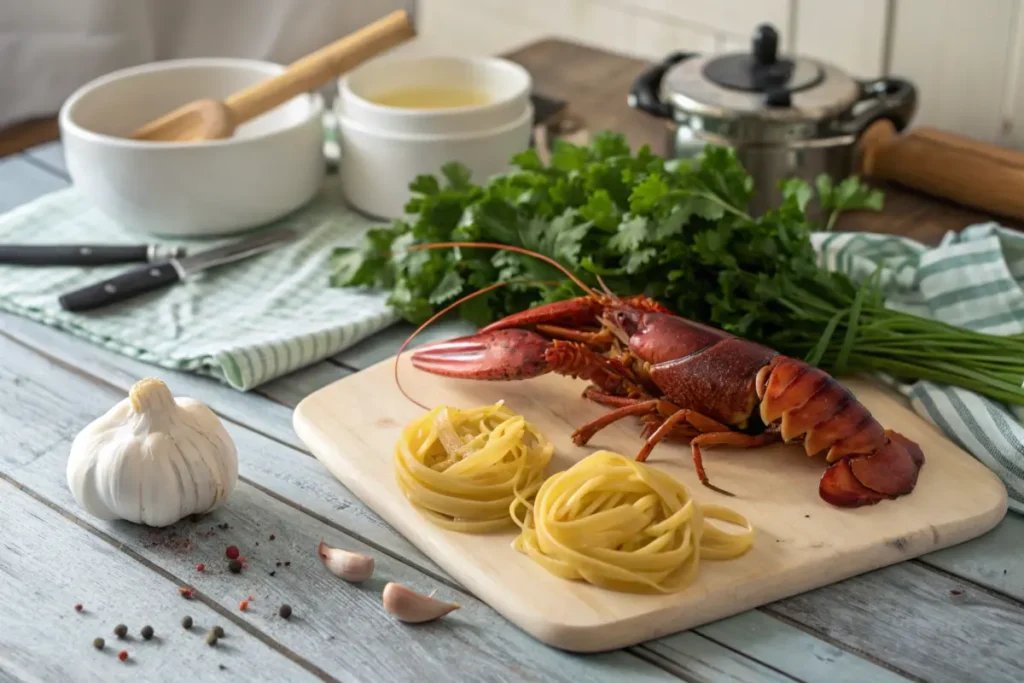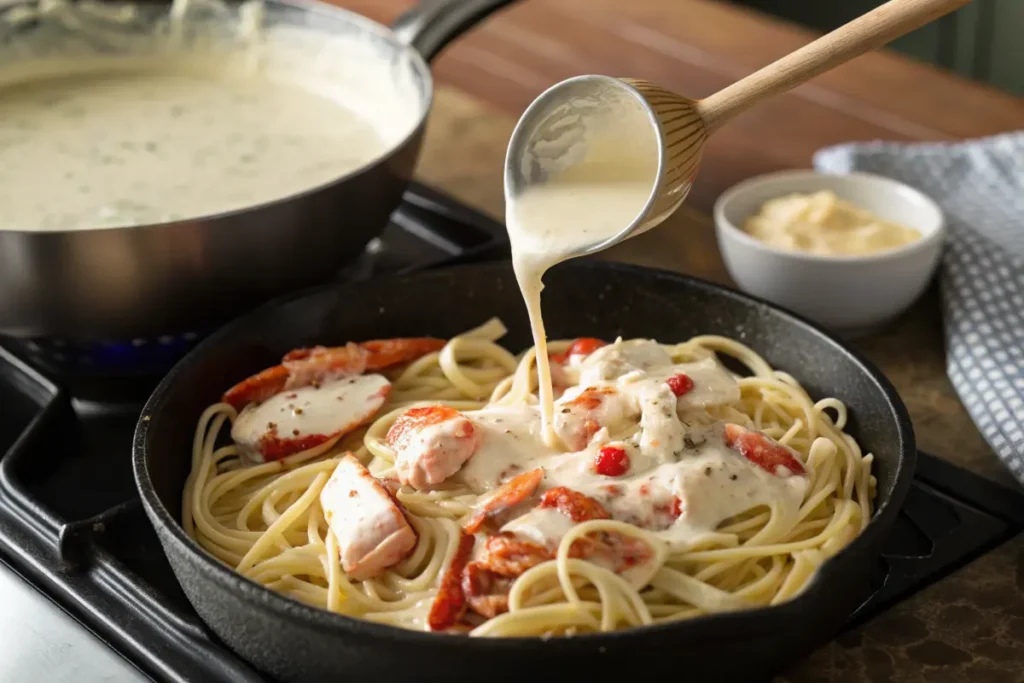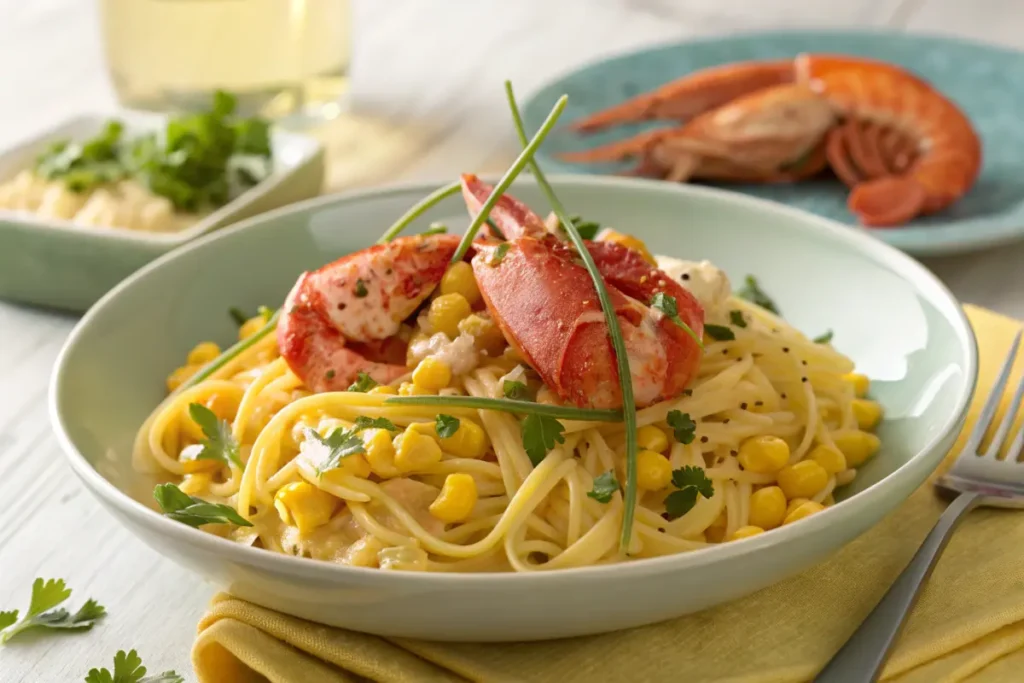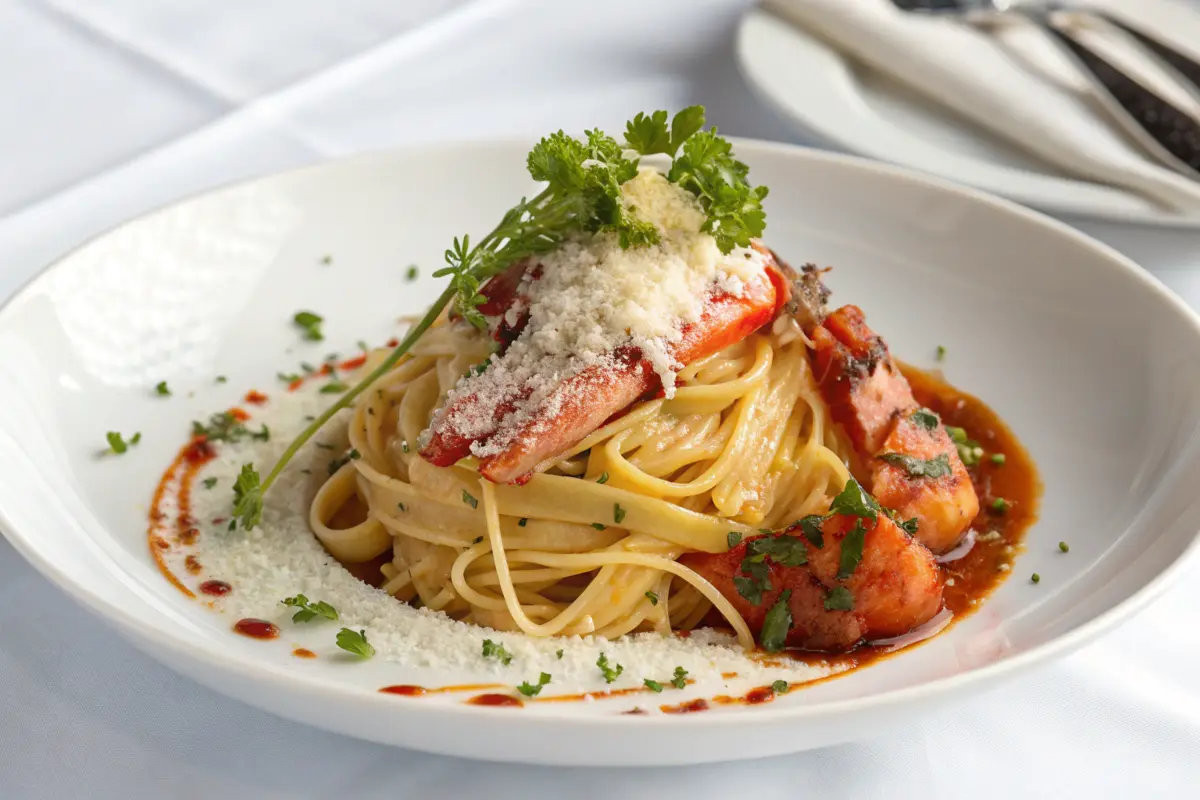Introduction
Few dishes exude elegance and comfort like lobster and pasta recipes. Combining the delicate sweetness of lobster with the heartiness of pasta creates a meal that’s both indulgent and versatile. Whether you’re preparing a classic dish like Lobster Alfredo or exploring a regional twist with lobster and corn pasta, the possibilities are endless. In this article, we’ll guide you through everything from selecting the best lobster and pasta to perfecting recipes, crafting sauces, and even answering common questions. Let’s dive in!
The Allure of Lobster and Pasta Combinations
Why Lobster and Pasta Are a Perfect Pair
There’s something magical about the pairing of lobster and pasta. The rich, buttery flavor of lobster beautifully complements the smooth textures of pasta, creating a culinary harmony that’s hard to resist. This combination has become a staple in fine dining as well as casual kitchens, offering endless opportunities for customization.
Not only do lobster pasta dishes appeal to a variety of palates, but they also offer a balance of protein and carbs, making them satisfying and versatile. Whether served with a creamy sauce, a spicy tomato base, or a light garlic-infused dressing, these dishes cater to diverse preferences.
A Dish for Any Occasion
One of the reasons lobster and pasta recipes are so popular is their flexibility. They’re fancy enough for special occasions like anniversaries but straightforward enough for weeknight dinners. With the right recipe, you can transform simple ingredients into a meal that feels indulgent without being overly complicated.
From classic Italian-inspired dishes to creative twists like lobster macaroni and cheese, there’s a recipe for every mood and season. Whether you’re a beginner or a seasoned cook, the allure of lobster and pasta is irresistible.
Selecting the Perfect Lobster for Your Pasta Dish

Fresh vs. Frozen Lobster
When it comes to creating lobster and pasta recipes, starting with the best lobster makes all the difference. Fresh lobster is celebrated for its sweet, tender meat and rich flavor. Live lobster, in particular, ensures maximum freshness but requires some extra preparation. If convenience is a priority, high-quality frozen lobster tails or pre-cooked meat can still deliver delicious results.
The key to frozen lobster is proper thawing. Always defrost lobster in the refrigerator overnight to preserve its natural texture and flavor. Avoid rapid-thawing methods like microwaving, as these can compromise the meat’s quality.
Benefits of Live Lobster
Cooking live lobster gives you full control over the flavor and doneness of the meat. Look for lobsters that are active and have hard shells, which indicate that they’re meaty and fresh. While live lobster requires more effort to prepare, the reward is succulent, flavorful meat that elevates any dish.
Sustainability and Peak Quality
Sustainability is crucial when purchasing lobster. Opt for lobster sourced from fisheries certified by organizations like the Marine Stewardship Council to ensure responsible practices. For peak quality, buy lobster during its harvest season, typically late summer to early winter, depending on your location.
By selecting the best lobster for your pasta, you’re setting the stage for a dish that’s both ethical and delicious.
Choosing the Right Pasta to Complement Lobster
Long Pastas for Creamy Sauces
When crafting lobster pasta dishes, long pasta varieties like linguine, spaghetti, or fettuccine work wonderfully with rich, creamy sauces. The strands provide an elegant base for buttery or Alfredo-style recipes, allowing the sauce to coat evenly and enhance the lobster’s sweet, delicate flavor.
For example, Lobster Alfredo Linguine pairs perfectly with this pasta shape, creating a luxurious, restaurant-quality meal that’s simple to prepare. These long noodles bring a sense of sophistication to any lobster dish.
Shorter Shapes for Chunky Dishes
For chunkier, tomato-based recipes like Lobster Fra Diavolo, shorter pasta shapes such as penne, rigatoni, or fusilli are ideal. Their ridges and hollow centers trap the flavorful sauce, ensuring every bite is packed with taste. These shapes also work well in baked dishes like Lobster Mac and Cheese, where the pasta needs to hold up under layers of cheese and lobster meat.
Fresh or Store-Bought?
While store-bought pasta works perfectly well, making fresh pasta at home elevates the dish. Homemade pasta absorbs sauces more effectively and adds an artisanal touch to your recipe. Whether you choose fresh or dried pasta, selecting the right shape ensures your lobster and pasta recipe is a culinary masterpiece.
Classic Lobster and Pasta Recipes

Lobster Alfredo Linguine
When it comes to indulgent lobster and pasta recipes, Lobster Alfredo Linguine tops the list. This dish combines tender chunks of lobster meat with a rich, creamy Alfredo sauce that clings to every strand of linguine. To prepare, start by sautéing garlic in butter until fragrant, then whisk in heavy cream and grated Parmesan cheese for a luscious sauce.
Gently fold in cooked lobster meat, allowing the flavors to meld together. Toss the sauce with cooked linguine, ensuring every bite is coated. Garnish with fresh parsley and a squeeze of lemon for brightness. This dish is perfect for a romantic dinner or a sophisticated family meal.
Lobster Fra Diavolo with Spaghetti
For those who love a little heat, Lobster Fra Diavolo is a spicy and flavorful option. This Italian-American classic pairs lobster with a tangy tomato-based sauce infused with red pepper flakes and garlic. Begin by simmering crushed tomatoes with olive oil, onions, garlic, and chili for a bold, spicy base.
Add cooked lobster meat to the sauce, allowing it to absorb the fiery flavors. Toss with spaghetti and finish with fresh basil for an aromatic touch. This dish’s robust flavors perfectly balance the lobster’s natural sweetness, creating an unforgettable culinary experience.
Lobster Macaroni and Cheese
Who says comfort food can’t be luxurious? Lobster Mac and Cheese takes a classic dish to new heights by incorporating chunks of succulent lobster into a creamy cheese sauce. Use a blend of sharp cheddar, Gruyère, and Parmesan to achieve the perfect flavor balance.
Cook elbow macaroni until al dente, then mix it with the cheese sauce and lobster meat. Transfer the mixture to a baking dish, sprinkle with breadcrumbs, and bake until golden and bubbling. This crowd-pleaser is ideal for family gatherings or potlucks, offering a decadent twist on a familiar favorite.
Regional Variations of Lobster Pasta

Italian-Inspired Lobster Tagliatelle
Italian cuisine celebrates simplicity, and Lobster Tagliatelle is a testament to that philosophy. This dish highlights the fresh flavors of lobster with a light sauce made from olive oil, garlic, and fresh herbs like parsley and thyme.
Cook the tagliatelle until al dente, then toss it with the sauce and lobster meat. A sprinkle of lemon zest adds a refreshing brightness. This recipe emphasizes the natural sweetness of lobster, making it a perfect choice for those who appreciate delicate, nuanced flavors.
New England Lobster and Corn Pasta
Inspired by the flavors of coastal New England, this dish combines lobster with sweet corn and a buttery sauce. Start by sautéing fresh corn kernels in butter with a touch of garlic and thyme. Add cooked lobster meat and a splash of cream to create a velvety sauce.
Toss the mixture with your favorite short pasta, like penne or rigatoni, and finish with a sprinkle of chives. The combination of sweet corn and lobster evokes the essence of a classic New England summer meal, perfect for warm evenings or nostalgic cravings.
Asian Fusion Lobster Pad Thai
For a bold and unexpected twist, try Lobster Pad Thai. This fusion dish blends the tender sweetness of lobster with the tangy, savory, and slightly spicy flavors of traditional Pad Thai. Use rice noodles as the base, and prepare a sauce with tamarind paste, fish sauce, and a hint of brown sugar.
Cook the noodles and toss them with the sauce, cooked lobster, scrambled eggs, and bean sprouts. Garnish with crushed peanuts, lime wedges, and fresh cilantro for an authentic finish. This recipe is perfect for adventurous eaters looking to explore global flavors.
Incorporating Seasonal Ingredients
Spring: Lobster and Asparagus Fettuccine
Spring is synonymous with freshness, and Lobster and Asparagus Fettuccine embodies the season perfectly. The tender sweetness of lobster pairs beautifully with the crisp, earthy notes of fresh asparagus. Begin by blanching asparagus until tender-crisp, then sauté it in olive oil with minced garlic.
Combine the asparagus with cooked lobster meat and toss with fettuccine in a light lemon-butter sauce. A sprinkle of Parmesan and a hint of fresh parsley complete this vibrant dish. It’s an excellent way to celebrate the season’s bounty with a simple yet elegant recipe.
Summer: Lobster and Tomato Basil Penne
Summer dishes are all about bright, bold flavors, and Lobster and Tomato Basil Penne delivers just that. Juicy, sun-ripened tomatoes and fragrant basil create a sauce that’s fresh and light, allowing the lobster to shine.
Prepare a simple tomato sauce by sautéing diced tomatoes, garlic, and onion in olive oil. Add cooked lobster meat and fresh basil leaves, then toss the sauce with penne pasta. Finish with a drizzle of olive oil and a sprinkle of red pepper flakes for a touch of heat. This dish is perfect for al fresco dining on warm summer evenings.
Fall: Lobster and Pumpkin Ravioli
The comforting flavors of fall take center stage in Lobster and Pumpkin Ravioli. The sweet, nutty taste of pumpkin complements the rich, buttery flavor of lobster, making this dish a seasonal favorite.
Prepare or purchase fresh pumpkin ravioli, then toss it with a creamy sauce made from browned butter, sage, and a splash of cream. Fold in cooked lobster meat and finish with a dusting of nutmeg. This hearty, flavorful dish is perfect for cozy dinners when the air turns crisp.
Winter: Lobster and Mushroom Pappardelle
Winter calls for rich, warming dishes, and Lobster and Mushroom Pappardelle fits the bill. This hearty recipe combines the earthiness of mushrooms with the luxurious sweetness of lobster. Sauté a mix of mushrooms—like cremini, shiitake, or oyster—in butter with garlic and shallots.
Add cooked lobster meat and a splash of cream to create a velvety sauce. Toss the mixture with wide pappardelle noodles and garnish with chopped thyme or parsley. This comforting dish is perfect for cold winter nights, offering a touch of indulgence to brighten the season.
Wine Pairings for Lobster Pasta Dishes
Pairing the right wine with lobster and pasta recipes elevates the entire dining experience. For creamy dishes like Lobster Alfredo or Lobster and Mushroom Pappardelle, opt for a crisp white wine such as Chardonnay. Its buttery notes harmonize with rich sauces, creating a seamless blend of flavors.
For lighter recipes, such as Lobster and Tomato Basil Penne or Lobster Tagliatelle, Sauvignon Blanc is an excellent choice. Its zesty acidity balances the dish’s bright and fresh ingredients.
If you’re preparing a spicier dish, like Lobster Fra Diavolo, consider sparkling water or a crisp, slightly sweet beverage that can counter the heat and enhance the flavors.
When in doubt, focus on pairing the wine with the sauce rather than the lobster. A well-matched drink amplifies the flavors of your dish and turns your meal into an unforgettable event.
Tips for Cooking Lobster Perfectly
Boiling vs. Steaming Lobster
When preparing lobster for pasta recipes, the cooking method plays a critical role in determining flavor and texture. Boiling is a quicker option and works well if you need a fully cooked lobster to extract meat easily. To boil, bring a large pot of salted water to a rapid boil, then submerge the lobster for about 8–12 minutes, depending on its size.
Steaming, on the other hand, enhances the lobster’s natural sweetness and prevents it from absorbing too much water. Place the lobster in a steamer basket over boiling water and cook for 10–14 minutes. Steaming is ideal for recipes where the lobster’s pure flavor takes center stage, like Lobster Alfredo.
Extracting Meat from Lobster Shells
Removing lobster meat can seem daunting, but it’s straightforward with the right technique. Start by twisting off the claws, cracking them with a lobster cracker, and pulling out the meat. Next, separate the tail from the body, flatten it gently, and use kitchen shears to cut along the underside of the shell. Pull out the tail meat in one piece, and don’t forget the tender meat in the small legs.
Save the shells! They can be simmered to create a flavorful lobster stock for sauces or soups.
Avoiding Common Mistakes
Overcooking is the most common mistake when preparing lobster. Keep an eye on cooking times to ensure the meat remains tender. Undercooked lobster has a translucent appearance, while perfectly cooked lobster is opaque and firm.
Avoid overcrowding your pot or steamer, which can lead to uneven cooking. For added flavor, cook lobster with aromatics like bay leaves, garlic, or lemon slices. By mastering these tips, you’ll ensure your lobster pasta dishes turn out perfectly every time.
Making Homemade Pasta for Lobster Dishes
Basic Pasta Dough Recipe
Homemade pasta elevates your lobster and pasta recipes to gourmet levels. To make fresh pasta dough, combine 2 cups of all-purpose flour with 3 large eggs in a mixing bowl. Form a well in the flour, crack the eggs into the center, and gradually mix until a dough forms. Knead for about 10 minutes until smooth and elastic, then wrap in plastic and let it rest for 30 minutes.
Shaping and Drying Pasta
Once rested, roll out the dough using a pasta roller or rolling pin until thin. Cut into desired shapes based on your dish. For Lobster Alfredo, wide fettuccine ribbons work beautifully. For chunkier recipes like Lobster Macaroni, create small tubular shapes.
After shaping, let the pasta dry slightly on a floured surface or drying rack. This prevents sticking and ensures the pasta holds up well during cooking.
Tips for Pairing Homemade Pasta with Lobster
Homemade pasta has a tender texture and fresh taste that complements lobster’s delicate flavor. Pair rich sauces like creamy Alfredo with flat noodles, or light olive oil-based sauces with thin spaghetti or linguine. Cooking fresh pasta takes just 2–3 minutes, so keep an eye on it to prevent overcooking.
The effort of making fresh pasta is well worth it. Not only does it enhance your dish’s flavor and texture, but it also adds a personal touch that makes every bite unforgettable.
Enhancing Flavor with Sauces
Creamy Garlic Butter Sauce
A creamy garlic butter sauce is the ultimate pairing for lobster and pasta recipes. Its richness enhances lobster’s natural sweetness, creating a velvety texture that coats the pasta perfectly. To make this sauce, melt 4 tablespoons of butter in a skillet, then sauté minced garlic until fragrant. Add 1 cup of heavy cream and simmer until thickened.
Stir in grated Parmesan cheese and season with salt, pepper, and a pinch of nutmeg for depth. Toss the sauce with cooked pasta and lobster meat, ensuring every bite is indulgent and flavorful. Garnish with fresh parsley and a squeeze of lemon for a refreshing finish.
Spicy Tomato Marinara
For those who enjoy bold, tangy flavors, a spicy tomato marinara is a perfect match for lobster. Begin by sautéing onions, garlic, and red pepper flakes in olive oil. Add a can of crushed tomatoes, a teaspoon of sugar, and a splash of vegetable stock. Simmer for 20 minutes to develop the flavors.
Fold in cooked lobster meat and toss with spaghetti or penne. The sauce’s spice complements the lobster’s sweetness, creating a dish with vibrant and balanced flavors. For an extra kick, sprinkle in some cayenne pepper or paprika.
Tips for Perfecting Your Sauce Game
The key to a great sauce lies in its texture and seasoning. Use fresh ingredients whenever possible, and adjust the consistency by adding pasta water or reducing the sauce over low heat. For a final flourish, always toss your pasta in the sauce before serving to ensure every strand is evenly coated.
With these sauce recipes, your lobster pasta dishes will have a professional, restaurant-quality touch that will impress every guest.
Serving Suggestions and Side Dishes
Garlic Bread: A Classic Companion
No lobster pasta dish is complete without garlic bread. Its crunchy, buttery texture pairs perfectly with the smoothness of pasta. To make it, slice a baguette, brush each piece with a mixture of butter, minced garlic, and parsley, then bake until golden brown. For extra flavor, sprinkle with Parmesan before baking.
Fresh Salads: A Refreshing Contrast
A crisp salad adds a refreshing balance to the richness of lobster pasta. A simple green salad with mixed greens, cucumbers, and a lemon vinaigrette works wonderfully. For a heartier option, a spinach and strawberry salad with walnuts and goat cheese offers a sweet-savory profile that complements lobster’s delicate flavor.
Grilled Vegetables: A Healthy Side
Grilled vegetables are a light and nutritious addition to your meal. Zucchini, bell peppers, asparagus, and cherry tomatoes can be brushed with olive oil, seasoned with salt and pepper, and grilled until tender. The smoky, charred flavors of the vegetables contrast beautifully with the creamy or tangy sauces in lobster pasta dishes.
Serving Tips for a Perfect Presentation
Presentation matters when serving lobster pasta. Plate the pasta neatly, topping it with chunks of lobster and a drizzle of sauce. Arrange the sides—garlic bread, salad, or vegetables—around the main dish to create a visually appealing and satisfying meal.
These sides not only enhance the flavors of your lobster pasta but also round out the dining experience, making it both indulgent and balanced.
Storing and Reheating Leftovers
Leftover lobster and pasta recipes can be just as delicious the next day if stored and reheated correctly. To preserve flavor and texture, transfer any leftovers to an airtight container and refrigerate them within two hours of cooking. Properly stored, lobster pasta will last for up to three days in the fridge.
If you plan to keep it longer, freezing is an excellent option. Separate the pasta from the sauce (if possible) to avoid mushiness, and store them in freezer-safe containers for up to two months. Thaw frozen lobster pasta overnight in the refrigerator before reheating.
To reheat, use low heat to prevent overcooking. Warm the pasta on the stove with a splash of water or cream to restore the sauce’s consistency. Avoid using a microwave, as it can make the lobster rubbery. These simple tips will keep your leftovers tasting fresh and flavorful.
Frequently Asked Questions
Can I use frozen lobster for pasta dishes?
Yes, frozen lobster works well for pasta dishes, especially when fresh lobster is unavailable. Thaw it in the refrigerator overnight to maintain texture and flavor. Frozen lobster tails or pre-cooked meat are convenient options that still deliver delicious results in recipes like Lobster Alfredo or Lobster Mac and Cheese.
What type of pasta holds sauce best with lobster?
Pasta with a smooth surface, like linguine or fettuccine, is ideal for creamy sauces, while ridged pasta such as rigatoni or penne works best for chunky, tomato-based sauces. The choice of pasta should complement the sauce’s consistency to ensure every bite captures the flavors of the lobster and the sauce.
How do I prevent lobster from becoming tough?
Avoid overcooking! Lobster becomes tough and rubbery when cooked for too long. Use a timer to ensure proper cooking—lobster is done when it turns opaque and firm. When reheating, do so on low heat and avoid microwaving to maintain its tender texture.
Can I substitute other seafood for lobster in these recipes?
Yes, you can substitute crab, shrimp, scallops, or even chunks of firm white fish like cod for lobster. Each option offers a unique flavor and texture that pairs well with pasta and sauces, making your recipes versatile and adaptable to different seafood preferences.
What’s the best way to reheat lobster pasta?
Reheat lobster pasta gently to avoid overcooking the lobster. Warm it on the stove over low heat with a splash of water, broth, or cream to restore the sauce’s consistency. Stir frequently to distribute the heat evenly and ensure the dish retains its original flavors and textures.

